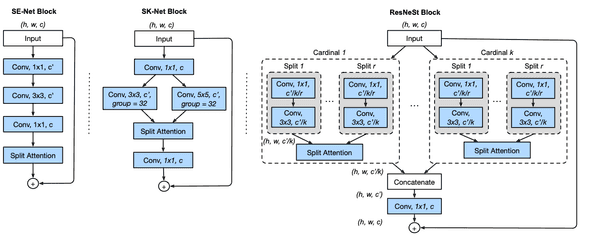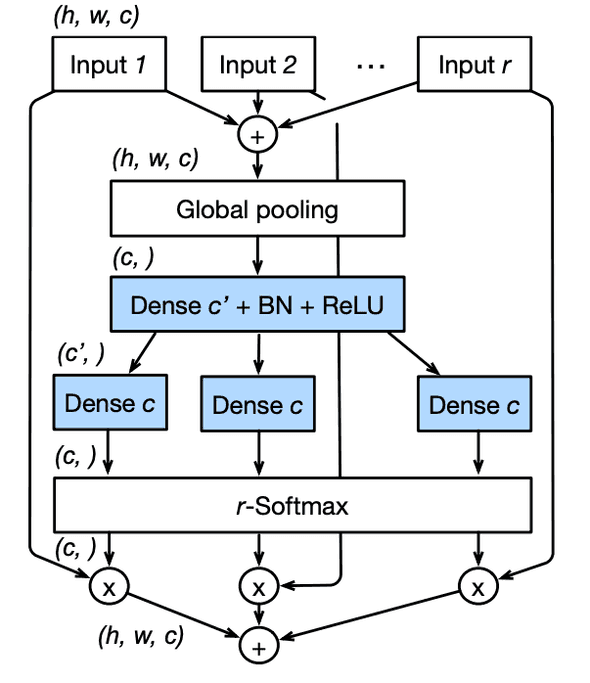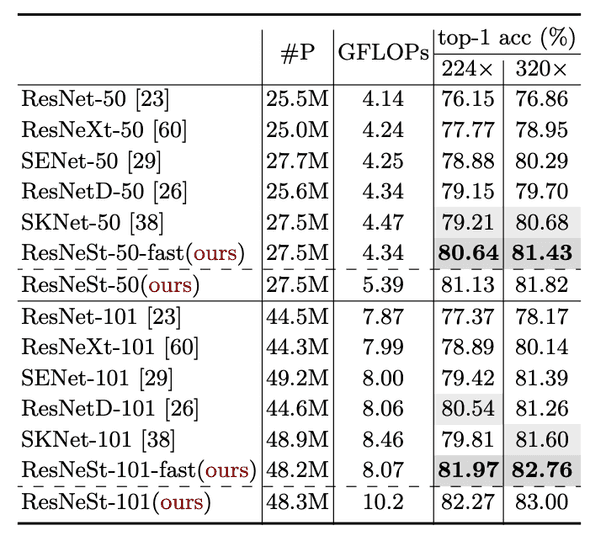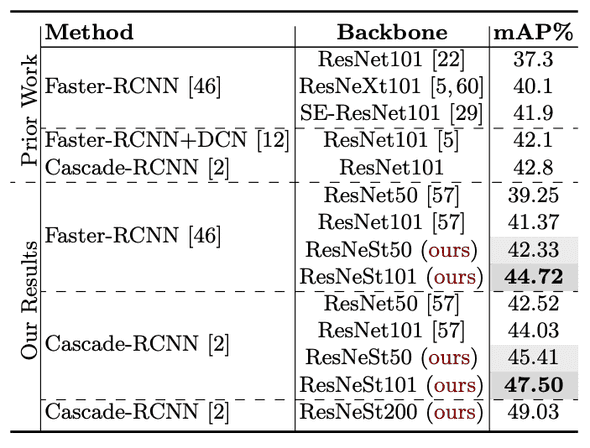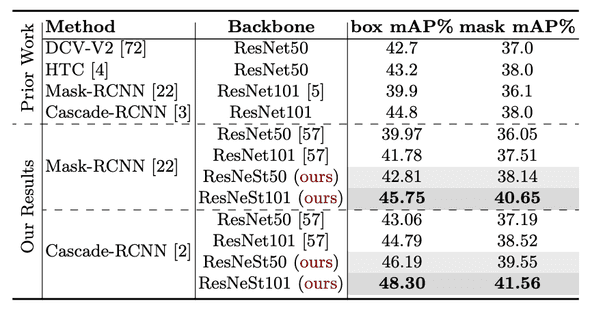TL;DR
Amazon 에서 지난달에 재밌는 논문이 나왔는데요, 새로운 image classification architecture 를 제안했는데, EfficientNet 보다 더 좋은 성능을 보이는 human-made architecture 를 선보였습니다. 멋지죠?
핵심은 Split-Attention 을 사용하는것 인데요, 자세한 건 본문에
결론은 ImageNet 에서 새로운 SOTA 를 찍었습니다.
paper : arXiv
code : github
Related Work
ResNet 계열 논문들
Introduce
introduction 에서는 크게 2가지 문제점들을 들면서 소개하는데요,
Computation
최근에 EfficientNet 같은 architecture 들을 보면 ImageNet 에서 정말 높은 acc 를 보여주고 있는데요, 그런데 성능은 정말 좋지만, AutoML 로 architecture search 를 하다 보니, accuracy 는 고려돼도, training efficiency 는 고려하지 못해서, 실제로 이걸 training 하려고 하면 computation cost 가 꽤 많이 듭니다.
Transfer Learning
위 architecture 들을 backbone 으로 하는 downstream task 들을 훈련할 때도 한계점으로 듭니다.
주로 ResNet 기반의 architecture 를 사용했는데, 요런 backbone 들은 해당 downstream task 에 optimal 한 구조가 아니기 때문에 (lack of receptive field, cross-channel interaction) 해당 task 들에 맞게 구조를 바꿔야 한다고 합니다.
또한, 실제로 EfficientNet 을 backbone 으로 사용할 때 다른 architecture 보다 성능이 고만고만한 경우도 꽤 있어요. (기대한 만큼 x)
요약하면, cross-channel representation 을 잘 뽑아주는 구조가 필요하다 입니다.
Architecture
아래는 이번 논문에서 제안한 Split-Attention 이 적용된 block 입니다.
왼쪽부터 순서대로 SE-Net block, SK-Net block, ResNeSt block 입니다.
ResNeSt 는 ResNeXt 와 SK-Net concept 을 합친 거라 보시면 될 듯 합니다.
Split-Attention Networks
Split-Attention block 은 크게 2가지 part 로 구성되어 있는데, feature-map group, split-attention operation 입니다.
feature-map group 은 ResNeXt 에 나오는 concept 이니 핵심인 split-attention 부분만 다뤄 보겠습니다.
- 각 cardinal group 에서 개의 splits 들에 대해 element-wise 하게 sum 해줍니다.
, for
- GAP 로 spatial features 를 squeeze 해 줍니다.
- Dense + BN + ReLU -> Dense 로 excitation 하고
- attention feature 와 original feature 하고 element-wise 하게 mul 해 주고
- 마지막으로 element-wise 하게 sum 해 줍니다.
ResNeSt Block
위 Split-Attention block 들이 각 cardinal group 별로 적용된 후에 모두 concat 후에 conv 1x1 되고 skip connection 이 element-wise sum 되는 형태 입니다.
만약 down-sample 되는 block 이라면 skip-connect 부분이 channel size alignment 를 위해 strided convolution or convolution + pooling 이 될 수 있다고 하네요.
Etc (computation, etc)
network 디자인을 봤을 때 computation 적으로 training 시 이전 구현체들 보다 효율적이다 등등을 말하네요
Training Recipe
요약
- average down-sampling : 이전 ResNet 들은 strided conv 3x3 w/ (zero padding) 로 pooling 함 -> avg pool 3x3 으로 pooling (zero-padding boundary 처리는 dense prediction task 에 sub-optimal 함)
- tweak ResNet-D : stem conv kernel size 가 7x7 -> conv 3x3 3층 (same receptive field 가지며, 더 computation 효율적으로)
- learning rate : lr = 0.1 로 5 epochs warm-up, cosine scheduling,
- BN : = 0 으로 init
- label smoothing 함
- AutoAugment 씀
- MixUp 씀
- Large Crop Size
- Regularization : DropBlock (p = 0.2) 씀, l2 weight decay
Experiment Result
ImageNet
ResNet based Benchmark
ResNet 계열 architecture benchmark 결과인데 제일 좋은 top-1 acc 를 보입니다.
SOTA Benchmark
이전 다른 SOTA 들하고 비교해 봐도 latency / accuracy 둘다 더 좋은 성능을 보여주네용
Transfer Learning Task
Downstream tasks 에서도 좋은 결과를 보이고 있습니다.
Object-Detection Benchmark
Instance Segmentation Benchmark
Semantic Segmentation Benchmark
Conclusion
요즘 architecture 들은 주로 baseline 구조에 AutoML 를 이용한 architecture search 가 이뤄지고 있는데, 이렇게 아직도 사람이 만든 architecture 에 대한 연구가 나오고 있고, 더 좋은 성능을 냈다는 게 정말 인상적이네요.
또 전에 구글에서 나온 논문 무언가에서 ResNet 의 모든 convolution 을 attention 으로 교체했더니 더 좋은 성능이 나왔다는 걸 본 적이 있는데, 여기서도 뭔가 더 아이디어를 얻어 볼 수 있을 것 같네요.
아마 제가 못 찾아본 거일 수도 있지만, Amazon 연구를 별로 본 기억이 없었는데, 이번 연구는 꽤 재밌었어요.
결론 : 굳굳굳
